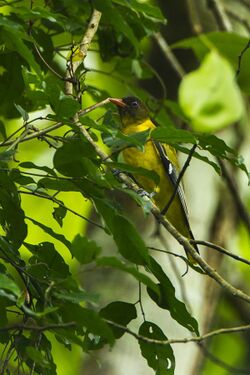Biology:Western oriole
| Western oriole | |
|---|---|

| |
| Scientific classification | |
| Domain: | Eukaryota |
| Kingdom: | Animalia |
| Phylum: | Chordata |
| Class: | Aves |
| Order: | Passeriformes |
| Family: | Oriolidae |
| Genus: | Oriolus |
| Species: | O. brachyrynchus
|
| Binomial name | |
| Oriolus brachyrynchus Swainson, 1837
| |
| Synonyms | |
| |
The western oriole (Oriolus brachyrynchus), or western black-headed oriole, is a species of bird in the family Oriolidae that is native to Africa. The adult upperparts are yellow-olive, and the underparts are yellow in colour. It is rated as a species of least concern on the International Union for Conservation of Nature Red List of Endangered Species.
Taxonomy and systematics
The western oriole was first described in 1837 by the English ornithologist William John Swainson.[1] Alternate names for the western oriole include the black-headed oriole (not to be confused with another species of the same name, Oriolus larvatus) and greenish-backed oriole. Two subspecies are recognized:[2]
- West African black-headed oriole (O. b. brachyrynchus) – Swainson, 1837: Found from Guinea-Bissau to Togo and Benin
- Cameroon black-headed oriole (O. b. laetior) – Sharpe, 1897: Found from Nigeria to western Kenya, south-central Democratic Republic of Congo and northern Angola
According to the genetic data, the western oriole and the green-headed oriole (Oriolus chlorocephalus) are sister species.[3]
Description
The western oriole measures 21 centimetres (8.3 in) in length, and weighs 42 to 57 g (1.5 to 2.0 oz).[3] The adult upperparts are yellow-olive in colour; the head to upper breast is black, and the periphery of the wings has a small white patch. It has a brownish pink beak. The underparts are yellow. The tail feathers are black and have broad yellow tips.[4]
The juvenile has olive upperparts. The head is olive, and the throat is streaked with yellow. It has a dusky beak, and black streaked breast.[4]
It has a variety of fluty vocalizations such as uoo-uoo, uoo-dleeo, tioolioo, whee-whooliu, whoolioo, and too-too-tuloo which normally have detached notes, and are lower pitched than those of the black-winged oriole (Oriolus nigripennis). It also emits a harsh whit-cheeew-cheeew.[4]
Distribution and habitat
The western oriole is native to the rainforests of Sierra Leone, Guinea, Liberia, Ivory Coast, Benin, and Ghana.[5]
It is found in western and central Africa. It lives either individually or in pairs in canopies of lowland primary forests, secondary forests, forest clearings with shrubs, and forest edges.[3][4]
Status and conservation
Since 1988, the western oriole has been rated as a species of least concern on the IUCN Red List of Endangered Species. This is because it has a very large range and because its population is thought not to have declined by 30% over ten years or three generations. Although the population size has not been measured, it is thought to be more than the threshold required to warrant it a vulnerable rating. Habitat loss is one reason for its population decline.[1]
References
- ↑ Jump up to: 1.0 1.1 1.2 BirdLife International (2018). "Oriolus brachyrynchus". IUCN Red List of Threatened Species 2018: e.T22706410A130377125. doi:10.2305/IUCN.UK.2018-2.RLTS.T22706410A130377125.en. https://www.iucnredlist.org/species/22706410/130377125. Retrieved 17 November 2021.
- ↑ "IOC World Bird List 7.1". IOC World Bird List Datasets. doi:10.14344/ioc.ml.7.1. http://www.worldbirdnames.org/ioc-lists/crossref.
- ↑ Jump up to: 3.0 3.1 3.2 Walther, B.; Jones, P. (2017). del Hoyo, Josep; Elliott, Andrew; Sargatal, Jordi et al.. eds. "Western Black-headed Oriole (Oriolus brachyrynchus)". Handbook of the Birds of the World Alive (Lynx Edicions). doi:10.2173/bow.wbhori1.01. http://www.hbw.com/species/western-black-headed-oriole-oriolus-brachyrynchus. Retrieved 2017-09-15.
- ↑ Jump up to: 4.0 4.1 4.2 4.3 Borrow, Nik; Demey, Ron (2013) (in en). Field Guide to the Birds of Ghana. Bloomsbury Publishing. pp. 280. ISBN 9781408189023. https://books.google.com/books?id=tcwXBAAAQBAJ&pg=PA280.
- ↑ Mason, Paul; Allsop, Jake (2009) (in en). The Golden Oriole. A&C Black. pp. 30. ISBN 9780713676839. https://books.google.com/books?id=XoN2lsGutpkC&pg=PA30.
External links
Wikidata ☰ Q1585741 entry
 |


